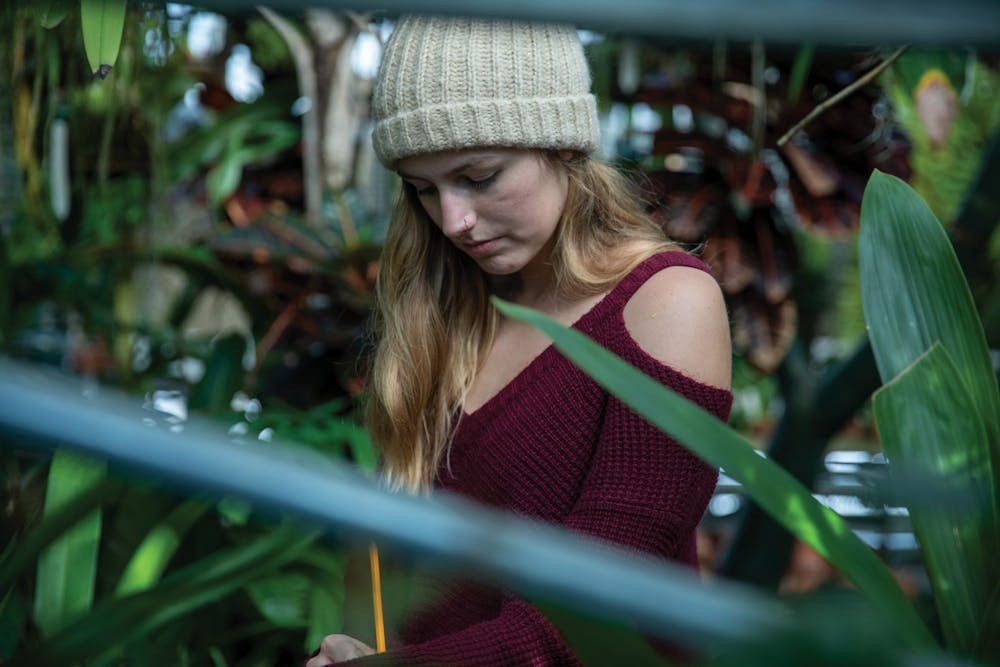Adopt-a-Plant corner:
In one of the corners of the Rinard Orchid Greenhouse, the greenhouse staff has a table lined with different plants for visitors to “adopt.” For the sale, the greenhouse currently offers sensitive plants and succulents. Plants range from $5-$20, depending on the type of plant. Each plant purchase is a donation to the greenhouse. Visitors can adopt as many plants as they would like and take them home to care for them on their own.
Editor's note: “On the clock” is a Ball State Daily News series profiling Ball State students and their on-campus jobs. If you have any suggestions as to who we should feature next, send an email to features@bsudailynews.com.
Dee Slagle, junior general studies major, said her plant-loving grandma inspired her green thumb and her passion for the solitude, peace and beauty of plants.
“I remember [my grandma’s] house being covered in plants when I was little,” Slagle said. “The one running joke is that if she plant-sits for you, [the plants] won’t come back because they want to stay at grandma’s.”
In her dorm room, Slagle said, she has 12 plants, including a Hibiscus tree she named Morgan Treeman.
“I name my plants because I adopted them into my little plant family,” Slagle said. “I think that they have their own little personalities. It also helps it seem like they have a place of belonging instead of just being a plant on a shelf.”
She continues to spread her love for the environment as a greenhouse keeper for Ball State’s Rinard Orchid Greenhouse, taking care of the largest university-based orchid collection in the United States.
“I have fallen in love with working there,” Slagle said. “I absolutely love working with animals [at the greenhouse too], and I was thrilled when I found out that I would be taking care of frogs, fish and turtles.”
Like Slagle, Sam Luginbuhl, senior wildlife biology major and another greenhouse keeper, said her love for plants, animals and nature started when she was young.
“Growing up, my mom was really into environmental-friendly things,” Luginbuhl said. “She always recycled, [and] she grew herbs and plants. I was always helping my mom with gardening and yard work. I helped my dad with yard work too.”
But, despite their prolonged love for the environment, both Slagle and Luginbuhl said, they didn’t initially plan to work at the greenhouse.
“I actually worked at the [Field Station and Environmental Education Center],” Luginbuhl said. “I was telling [Cheryl LeBlanc, curator of the Rinard Orchid Greenhouse] that I could work [at the greenhouse], and at first, she was like, ‘Well, you might not have enough hours,’ but then, she ended up not being able to find anyone, so I got the job.”
As for Slagle, she said her hiring process didn’t necessarily go as planned after she began applying through the Career Center.
“I didn’t know where I needed to go, so I strolled over to the greenhouse and started talking with Cheryl,” Slagle said. “What I didn’t realize is that I wasn’t supposed to just walk up to her and start an interview, I was supposed to go to Cooper Science and wait to get a call for an interview.”
When hiring students, the greenhouse staff looks for students like Slagle and Luginbuhl who have prior plant experience or interest.
“You don't have to be a biology major or botany [major,] but in your personal life, if you have a really strong interest in plants, that's always a big benefit,” said Erica Forstater, environmental education and greenhouse coordinator. “We really appreciate it when students volunteer with us first because that lets us actually know who you are. You'll already have some of the basics down, and we hope that you'll stay around for a long time.”
Now, both Luginbuhl and Slagle take turns performing a variety of tasks for the greenhouse.
Slagle said she works four days a week, and she starts her day by making new fly cultures and taking care of the greenhouse’s animals.
“Sometimes, I make the fertilizer for the watering, but that depends on the day of the week,” Slagle said. “I water the conservatory and squeegee the floor so that it can dry. We also have to record the temperatures of the houses to make sure that they are adequate for the plants.
“The biggest thing that captured my attention was the fact that we have to breed wingless fruit flies for the frogs to eat. It is really gross but also really neat to do.”
One of Luginbuhl’s largest tasks is unraveling the hose to water more than 2,000 orchids and other plants growing in the greenhouse.
“One big thing is just making sure that I'm watering everything properly,” Luginbuhl said. “Depending on how the weather is that day, I have to water the greenhouse specifically. There's thousands of plants in here, so I have to know each of their biological needs in order to water them correctly.”
Both Luginbuhl and Slagle have plants they favor over others. Luginbuhl said her favorite is the bucket orchid, which only blooms once a year, while Slagle prefers “the sensitive plants because you can scare them, and they shrink,” she said.
One of the benefits of working at the greenhouse is being surrounded by warmth during the winter, Slagle and Luginbuhl agreed.
“I know that's small, but I really enjoy that,” Luginbuhl said.
Working in the greenhouse has not only been a rewarding experience, Slagle said, but has also taught her discipline and responsibility.
“I have to make sure that I am paying attention to what I am doing. If I accidentally water a plant that is dormant for the season, it could jeopardize the blooming of the plant during its blooming season,” Slagle said. “I have to be aware of my actions because this is a house of living things. There are animals and plants that are very sensitive, and if something isn’t done properly, then it could harm them.”
Luginbuhl’s one wish for the greenhouse, she said, is she wants more people to know it exists.
“A lot of people really don't know that [the greenhouse] is here,” Luginbuhl said. “It's a little far, but it's worth it.”
Contact Taylor Smith with comments at tnsmith6@bsu.edu or on Twitter @taynsmithh.





